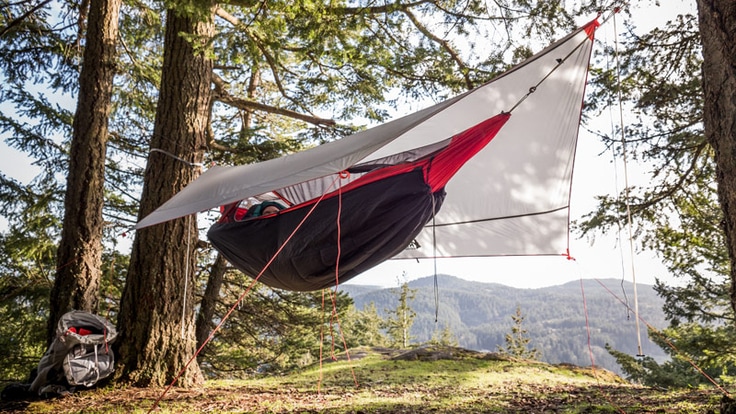- 8 Airplane Footrest Hammock!Travel comfortably - October 9, 2023
- top 7 Pool Float Water Hammock for a Relaxing Summer - October 9, 2023
- top 5 Space SaverSingle Hammock Stand Maximize Comfort and Space - October 9, 2023
To hang a hammock on rocks, you’ll need a ridgeline cord, rope, three carabiners, climbing cams, and climbing nuts. Use the metal wedges threaded on a wire and wedge them into the crack of rocks for added protection.
Preparing For Hanging
htmlWhen it comes to hanging a hammock on rocks, proper preparation is crucial. Before setting up your hammock, there are a few important steps to follow. In this section, we will discuss how to assess the rock surface, choose the right type of hammock, and gather the necessary tools and materials.
Assessing The Rock Surface
Before hanging your hammock, it’s essential to assess the rock surface to ensure it can support the weight. Look for stable and sturdy rocks that are free from loose debris or sharp edges. Make sure the rocks are securely anchored and won’t shift or slide, as this can pose a safety risk. It’s also important to check for any potential obstacles or hazards in the surrounding area.
Choosing The Right Type Of Hammock
When it comes to hanging a hammock on rocks, choosing the right type of hammock is key. Look for hammocks that are designed for outdoor use and are made from durable materials such as nylon or polyester. These materials are not only resistant to wear and tear but also dry quickly, making them ideal for rocky environments. Additionally, opt for hammocks with strong ropes or straps that can be securely fastened to the rock surface.
Gathering The Necessary Tools And Materials
Before you can hang your hammock on rocks, it’s important to gather the necessary tools and materials. Here are a few items you’ll need:
- Hammock: Choose a hammock that is suitable for outdoor use.
- Ropes or Straps: Ensure that the ropes or straps are strong and durable.
- Anchoring Hardware: Depending on the type of rock surface, you may need carabiners, hooks, or other anchoring hardware to securely attach the hammock.
- Tarp or Rainfly: If you’re planning to use the hammock in unpredictable weather conditions, it’s a good idea to have a tarp or rainfly to provide protection.
- Carabiners or Hooks: These will be used to attach the ropes or straps to the hammock and the rock surface.
- Protective Gear: Consider wearing gloves to protect your hands from sharp or rough surfaces.
By gathering these tools and materials beforehand, you’ll have everything you need to hang your hammock on rocks effectively and safely.
Securing Anchors On Rocks
When it comes to hanging a hammock on rocks, securing stable anchor points is crucial. Rocks can provide a beautiful and unique setting for hammock lounging, but finding suitable anchor points can be a challenge. In this guide, we’ll explore how to secure anchors on rocks, using slings and straps to attach the hammock, and ensuring proper tension and stability for a safe and enjoyable hammock experience.
Finding Stable Anchor Points
The first step in hanging a hammock on rocks is to identify stable anchor points. Look for large, sturdy rocks that are securely embedded in the ground. Avoid loose or brittle rocks that may shift or break under the weight of the hammock. It’s also important to consider the distance between the anchor points to ensure proper tension and support.
Using Slings And Straps To Attach The Hammock To Anchors
Once you’ve found stable anchor points, you can use slings and straps to attach the hammock. Slings are usually made of strong nylon webbing and are wrapped around the rocks to create a secure attachment. Straps, on the other hand, are wider and often come with adjustable loops or hooks that can be easily attached to the anchor points.
When attaching the hammock to the anchors, make sure to distribute the weight evenly to prevent any strain or damage. Avoid over-tightening the straps or slings, as this can create unnecessary tension and compromise the stability of the hammock setup.
Ensuring Proper Tension And Stability
Proper tension and stability are key to a safe and comfortable hammock experience. Once the hammock is attached to the anchor points, take the time to adjust the tension and make sure the hammock is level and balanced. Use a hammock suspension system that allows for easy adjustments, such as adjustable straps or carabiners
Be mindful of the angle of the hammock, as a flatter angle can provide a more comfortable and stable experience. Additionally, make sure the hammock is at a suitable height from the ground to prevent any accidental falls.
In conclusion, securing anchors on rocks requires careful consideration of stable anchor points, the use of slings and straps to attach the hammock, and ensuring proper tension and stability. By following these steps, you can enjoy the beauty of hammocking on rocks while having a safe and relaxing experience.
Setting Up The Hammock
When it comes to hanging a hammock on rocks, setting it up properly is crucial for stability and comfort. In this section, we will guide you through the steps to set up your hammock between rocks, adjust the height and angle, and ensure stability and comfort.
Positioning The Hammock Between Rocks
To begin, find two suitable rocks that are an appropriate distance apart and stable enough to support the weight of your hammock. Ensure the rocks are secure and free from any sharp edges or obstructions that may damage your hammock. Place the hammock straps or ropes around the rocks, making sure they are positioned snugly and securely.
Adjusting The Height And Angle Of The Hammock
Once the hammock straps or ropes are securely wrapped around the rocks, adjust the height and angle of the hammock according to your preferences for comfort and relaxation. You can raise or lower the height by adjusting the straps or ropes, and you can change the angle by positioning the hammock straps or ropes at different angles on the rocks.
Testing The Hammock For Stability And Comfort
After positioning and adjusting the hammock, it’s essential to test it for stability and comfort. Sit or lie down in the hammock and gently sway to ensure it is stable and properly balanced. Make sure there are no excessive sagging or bending of the straps or ropes, as this could indicate an unstable setup. Test different lying positions and adjust the angle and height as needed to find the most comfortable position.
By following these steps, you can confidently hang your hammock on rocks and enjoy the beauty of nature while relaxing in ultimate comfort.
Safety Tips And Considerations
Checking The Rock’s Stability Before Hanging
Before hanging your hammock on rocks, it is crucial to ensure that the rocks themselves are stable and secure. This is essential for your safety and the durability of your hammock setup. Here are some steps to follow when checking the stability of rocks:
- Inspect the rocks closely for any cracks or signs of weakness. Avoid hanging your hammock on rocks that appear unstable or crumbling.
- Give the rocks a gentle push or tap to test their stability. If they wobble or move easily, find a more secure spot to hang your hammock.
- Look for rocks that are firmly embedded in the ground or have natural ledges where you can securely hang your hammock.
- Avoid hanging your hammock on rocks that are positioned at a steep angle, as this can increase the risk of slipping or sliding.
Utilizing Protective Gear For Safety
When hanging a hammock on rocks, it is important to prioritize your safety. Using protective gear can help minimize the risk of accidents and injuries. Here are some safety accessories you should consider:
- Hammock straps or tree protectors: These accessories provide a protective barrier between your hammock and the rocks, preventing any possible damage to the hammock fabric.
- Carabiners and sturdy ropes: Use high-quality carabiners and ropes to securely attach your hammock to the rock anchors. Ensure they are rated for the weight capacity required for your hammock.
- Hammock suspension systems: Opt for suspension systems that offer advanced safety features, such as adjustable straps with multiple attachment points, reinforced stitching, and reliable buckles.
Being Mindful Of Potential Hazards And Risks
While hanging a hammock on rocks can provide a unique and picturesque experience, it is important to be aware of potential hazards and risks. Consider the following:
- Weather conditions: Be mindful of weather conditions that could affect the stability of the rocks, such as heavy rain or strong winds. Avoid hanging your hammock during inclement weather.
- Wildlife and insects: Research the area for any potential wildlife or insect risks. Take necessary precautions, such as using insect repellent or choosing a location away from known nesting areas.
- Rock surface temperature: Rocks exposed to direct sunlight can become extremely hot. Be cautious when touching or leaning against rocks to avoid burns or discomfort.
- Personal comfort: Ensure that the location and height at which you hang your hammock are comfortable and suitable for your personal preferences. Improper positioning can lead to discomfort or potential accidents.
By following these safety tips and considerations, you can enjoy a safe and relaxing hammock experience while hanging it on rocks. Remember to prioritize your safety and take necessary precautions to ensure a stable, secure, and enjoyable setup.
Enjoying Your Hammock On Rocks
Relaxation And Comfort In A Natural Setting
Enjoying your hammock on rocks offers a unique and tranquil way to relax in a natural setting. The combination of the gentle sway of the hammock and the soothing sounds of nature can create a truly serene experience. Whether you are camping, hiking, or simply exploring the great outdoors, hanging a hammock on rocks allows you to unwind and recharge while immersing yourself in the beauty of nature.
Tips For A Memorable Hammock Experience
To make the most of your hammock experience on rocks, consider the following tips:
- Choosing the right location: Look for a spot where the rocks are sturdy and stable enough to support your weight. Avoid sharp edges or unstable surfaces that could pose a safety risk.
- Using secure anchors: Use strong straps or ropes to securely anchor your hammock to the rocks. Ensure that the anchors are tightly secured and provide a stable support system.
- Selecting the right hammock: Opt for a hammock that is designed for outdoor use and can withstand rugged conditions. Look for hammocks made of durable materials that are resistant to weathering.
- Adding comfort: Enhance your hammock experience by bringing along pillows, blankets, or even an inflatable mattress to increase your comfort level.
- Protecting yourself from the elements: Consider using a hammock with a built-in bug net or bring along a lightweight tarp to protect yourself from insects and unexpected weather conditions.
Leaving No Trace: Properly Packing And Cleaning Up
When enjoying your hammock on rocks, it’s essential to follow the principles of Leave No Trace to ensure that you preserve the natural environment and minimize your impact:
- Pack out what you pack in: Take all your belongings and trash with you when you leave the area. Leave the rocks and surroundings as you found them.
- Dispose of waste properly: If there are no designated waste bins nearby, pack your trash in a sealed bag and dispose of it in the appropriate receptacle when you have access to one.
- Minimize campfire impact: If you plan to have a campfire, use existing fire rings or designated fire pits. Make sure to completely extinguish the fire and return the rocks to their original state.
- Respect wildlife: Keep your distance from any wildlife you encounter and avoid feeding or disturbing them. Observe from a distance and leave no trace of your presence.
By following these tips and practicing responsible outdoor etiquette, you can enjoy your hammock on rocks while respecting and preserving the natural environment for future generations to enjoy.

Credit: www.rei.com
Frequently Asked Questions Of How Do You Hang A Hammock On Rocks
How Do You Set Up A Hammock Without Trees?
To set up a hammock without trees, you have a few options:1. Use a Ground Conversion Kit to match your tree tent model. 2. Build your own wooden posts in concrete. 3. Use a hammock stand or frame. 4. Use vehicles as anchor points.
5. Improvise with available supports like poles or fence posts.
What Is The Best Way To Hang A Hammock?
To hang a hammock between rocks, you’ll need a ridgeline cord, rope, carabiners, and climbing cams or nuts for protection. Wrap your straps around the rocks and secure them tightly. Attach the ridgeline cord to the straps and hang your hammock using carabiners.
Ensure everything is secure before getting in.
How Do You Hang A Hammock Without A Stand?
To hang a hammock without a stand, find a stable pole or post like a fence post or telephone pole. Make sure it can support your weight by giving it a shake. Use a ridgeline cord, rope, carabiners, and climbing cams and nuts to secure it between rocks.
What Are The Anchor Points For A Hammock?
To hang a hammock between rocks, you’ll need a ridgeline cord, rope, carabiners, climbing cams, and climbing nuts for protection. Use the metal wedges threaded on a wire to wedge into the crack of the rocks. This will serve as anchor points for your hammock.
Can You Hang A Hammock On Rocks?
Yes, you can hang a hammock on rocks by using anchors and straps specifically designed for rocky surfaces.
How Do I Secure A Hammock On Rocks?
To secure a hammock on rocks, use rock climbing anchors or loop straps around sturdy rocks and fasten them tightly.
What Are The Best Anchor Points For A Hammock On Rocks?
The best anchor points for a hammock on rocks are large, solid rocks or boulders that can support the weight and provide stability.
Conclusion
Wrapping up, hanging a hammock on rocks requires proper equipment such as ridgeline cord, rope, carabiners, climbing cams, and nuts. By using metal wedges threaded on a wire and wedged into the cracks of rocks, you can ensure stability and protection.
Remember that safety is paramount, so double-check the stability of the rocks and always use appropriate gear. Now, go out and enjoy a relaxing hammock experience in nature’s rocky embrace!






